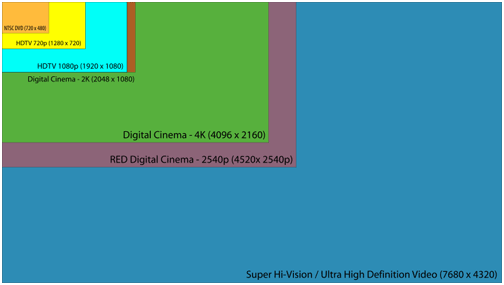
4K UltraHD, also known as Ultra High Definition, Ultra HD or 4K, is a video format conceptualized by the Japanese public broadcasting network, NHK. On October 17, 2012, The Consumer Electronics Association (CEA) announced that the official term “Ultra HD” would be used for any display with a 16 x 9 ratio with at least 1 digital input cable carrying a minimum resolution of 3,840 x 2,160 square pixels.
ITU Recommendation for Ultra HDTV
ITU-R Recommendation BT.2020 (also known as “Rec. 2020”) was posted on the International Telecommunication Union (ITU) website on August 23, 2012. Rec. 2020 defines various aspects of ultra high definition television such as display resolution, frame rate, chroma subsampling, color depth, and color space.
Ultra HDTV Resolution
4K Ultra HD (2160p) has a resolution of 3840×2160 (8.3 megapixels), which is roughly equivalent to 4K cinema or 4 times the number of pixels in HD format (1080p).
Ultra HD Frame rate
While Rec. 2020 allows for Ultra HDTV frame rates ranging from 23.976 to 120, there are limitations with the current HDMI 1.4 specification, which means that all current Ultra HD devices offer a maximum of 3840×2160 @ 30fps.
Ultra HD Color space
The Rec. 2020 color space can reproduce colors that cannot be shown with the Rec. 709 (HDTV) color space. In coverage of the CIE 1931 color space the Rec. 2020 color space covers 75.8%, digital cinema covers 53.6%, the Adobe RGB color space covers 52.1%, and Rec. 709 covers 35.9%
Ultra HD Luma coefficients
Rec. 2020 specifies that if a luma (Y’) signal is made that it uses the R’G’B’ coefficients 0.2627, 0.6780, and 0.0593.
Ultra HD Transfer characteristics
Rec. 2020 defines the non-linear transfer function that can be used for gamma correction. 10-bits per component Rec. 2020 uses the same formula that is used by Rec. 709. 12-bits per component Rec. 2020 makes a single change in the formula in that the minimum point on a 0 to 1 light intensity range where the non-linear transfer function begins is raised from 0.018 to 0.0181. Both Rec. 2020 and Rec. 709 use Illuminant D65 for the white point.
More at Nanotech.com

